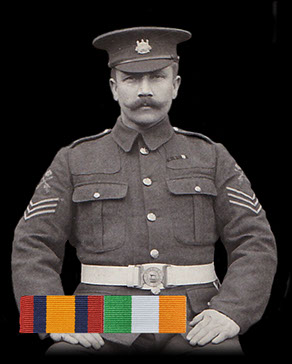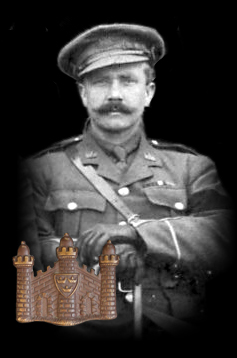Captain Thomas William Cutting
Known to most people by his middle name, William, he was every bit the old soldier, in both appearance and career. He was born in 1876 at Bury St Edmunds, his father was an agricultural labourer born at Rougham and his mother came from Cambridge.
William joined the Suffolk Regiment on the 2nd January 1894, aged 18, having already spent time training with the Suffolk Militia. He was given the regimental number 3729 and very quickly started to prove himself a good and reliable soldier.
By late 1894 William had already been promoted to Lance Corporal and was serving with the 1st Battalion. In December of the following year, while posted to the Depot, he was involved in a fight in Bury St Edmunds after some locals singled William and another soldier out as looking "tough". He was struck in the face by a stick and was left with a nasty scar by his mouth.
In August 1896 William was promoted once again and made a Corporal. In 1898 he spent a year at Malta before coming home and undergoing training for the Mounted Infantry. He left the UK after being made a Sergeant and went with the 1st Mounted Infantry to South Africa to fight in the Second Boer War. He fought and served in numerous location and was awarded the Queens South Africa Medal with 5 clasps and the Kings South Africa medal with 2 clasps.
William returned home to the UK in September 1902 and returned to the 1st Battalion. In August 1904 he was promoted to Colour Sergeant and the following year after completing his 12 years of service re-engaged, signing up to do a full 21 years of service. William married Ellen Britton at Farnham in 1905, their first child was born the following year and their second in early 1908.
Shortly after the birth of their second child William was posted to Malta once again and remained there for two years. After returning home in April 1910 he accepted a posting to the Permanent Staff of the Cambridgeshire Regiment. He was given the position of Instructor for H Coy and moved to Ely with his family. The position included a house and William and his family lived on Silver Street in one of the old militia houses.
As a Sgt Instructor William was kept busy overseeing the running of the Coy. He was responsible for much of the administration and the training of new recruits. He played a vital part in the overall efficiency of the unit and it was a role he excelled in. The role led to him being well known and a sight around Ely.
After over three years at H Coy, William's hard work was recognised and he was once again promoted, this time to Acting Sergeant Major of the Cambridgeshire Regiment. He was also awarded his Long Service and Good Conduct medal. The new position of Sergeant Major was based at Cambridge so along with his family they moved to Vinery Road, Cambridge. William and Ellen's third child was born at Cambridge in July 1914.
The promotion to Sgt Maj coincided with a huge increase in activity and recruiting. William was kept very busy especially after the January 1914 recruiting week. After the outbreak of war in August 1914 the Permanent Staff attached to the Cambs were returned back to the Suffolk Regiment except William. The loss of all the other instructors complicated training in the early days of the war and William was constantly busy. His discipline and drive became crucial elements in preparing the Cambs for war.
By the time that orders came through for the Cambs to go to France, William had already served over 21 years in the Army. On the eve of the Battalion leaving for France the paperwork came through giving him a commission to the rank of Honorary Lieutenant and Quartermaster.
As the 1/1st Cambs Quartermaster, William sailed with the rest of the Battalion on the the 14th February 1915 and arrived at Le Harve on the 15th. The role of QM meant that William was responsible for making sure the Cambs were kept supplied with everything from food to ammunition. He also saw to the burial of many of the Cambs early casualties and took it upon himself to write to many of their next of kin (see Fig. A).
The events of 1915 and the winter took their toll on William and in mid January 1916 he returned to the UK. Once home he was posted to the 3/1st Battalion and promoted to Lieutenant and later Temporary Captain. After the 3/1st was merged into the Cambs and Suffolk Reserve Battalion, William was posted to the 51st (Graduated) Battalion, Hampshire Regiment. The 51st (Graduated) Battalion was a training unit for soldiers still too young to go overseas. While here he was confirmed as Captain and made the Battalion Adjutant.
William was finally discharged from the Army after the war and by 1921 moved back to Bury St Edmunds and then later Ipswich. He died at Ipswich in 1954.

William in 1912 as Sgt Instructor for H Coy.
Fig. A Part of a letter written by William to the parents of Monty West, a young Cambs Lt killed in May 1915.
It is with sincere regret that I have to announce the burial of you son, Lieut. W.M. West, who died of wounds received on May 5th and was buried very comfortably on the May 6th by the Quartermaster Sergeant's staff and a few details which I had under my charge. The burial took place where the first line of transport was stationed when the Colonel left the Battalion, so should you run across Col. Copeman he will be able to tell you the exact spot. I might say that as I was unable to see him in hospital alive I requested the chaplain at the funeral that I might see him and I am pleased to say he looked quite peaceful and I am having a cross erected.

William while with the 3/1st Battalion.

This site went live on the 14th February 2015 to mark 100 years since the 1/1st Cambs went off to war.
WE WILL REMEMBER THEM
Email us: cambsregt@gmail.com
Copyright 2015, 2016, 2017, 2018, 2019 by Felix Jackson. The information and images on this site should not be reproduced without prior permission.